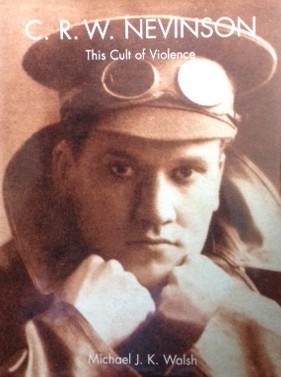Inspiring Older Readers
 posted on 30 Sep 2017
posted on 30 Sep 2017
C.R.W. Nevinson: This Cult of Violence by Michael J.K. Walsh
Christopher (usually known by the initials C.R.W.) Nevinson (1889 – 1946) was one of the best regarded but most controversial British artists of the first half of the 20th century. He studied at the famous Slade School of Art where he found himself alongside Stanley Spencer and Mark Gertler but it was his relationship with the Italian Futurist, Marineti that had the biggest influence on his development in the early part of his career. Declaring himself a Futurist he tried to get the writer and painter Wyndham Lewis to join the movement but this caused a rift between the two and Lewis instead founded the Vorticists and excluded Nevinson from membership.

But it was the outbreak of the First World War that brought Nevinson what would be his lasting fame. At the outbreak of war he joined a Quaker medical corps and was frequently disabled by rheumatism – a medical condition that also limited his participation in the ambulance service to which he was assigned. He was still able to paint though and he continued to exhibit his art throughout the early years of the war.
In 1917 he became an official war artist and this seemed to trigger a series of clashes with the authorities who often took umbrage with his chosen subjects – his painting of a group of British soldiers standing talking was dismissed as unsuitable because the ‘kind of men’ shown in the painting did no justice to the British soldier!

Relationships with authority continued to deteriorate until the end of the war and when he felt he had been snubbed by having his painting for the Imperial War Museum hung in a side room it signalled a complete breakdown with them and poisoned future relationships.
Michael Walsh’s book deals in some detail with Nevinson’s career to this point in 1919 and it’s an excellent and quite racy read that is laced throughout with his delicious paintings. I personally found his pre-war Futurist work just ok but his war paintings are sensational. The subject matter is, of course, dramatic in its own right but the Futurist influences and a good dollop of Cubism combine to create a style that somehow captures the experience and terror of war in an original and striking fashion.


Walsh’s book is really an analysis of the life of a painter in his early years rather than a coffee-table art book and it’s all the better for that in my view. The paintings here are allowed in as necessary illustration rather than the central focus and because of that it’s easier to appreciate their strengths and their impact. In writing the book Walsh has had access to a previously unexamined archive and has draw on contemporary press coverage to fill in details of how Nevinson’s work was received by his contemporaries.
The book’s not cheap though. You may well have to pay the best part of £40 to buy a copy online but I would advise you to keep your eyes open for a copy in a charity bookshop and you might well pick up a copy as I did for a lot less.
Terry Potter
September 2017

